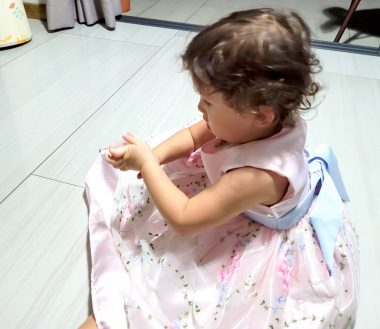How We Create Halloween Family Traditions Our Own Way
Parents help their AADC-deficient daughter enjoy the holidays with comfort

Our first Christmas Eve as a family was spent in a park. My wife, Judy, and I sat on a bench, trying to comprehend what was happening to our daughter, Rylae-Ann. In December 2018, we had a clue what she had, but we had no idea what aromatic l-amino acid decarboxylase (AADC) deficiency would mean for our family long-term. But I promised my wife on that bench that we’d never have a holiday like that again.
It took some time for us to adapt to rare disease life, but already we’d begun handling holidays by making adjustments. Growing up, I remember celebrating all the important holiday events. Excitement abounded, and I remember dressing up, eating delicious foods, and gathering with family and friends.
With a daughter with AADC deficiency, all that seemed impossible. But in time we learned how we could celebrate. Maybe we couldn’t do all the traditions as others did. However, our family was not excluded from making our own traditions. We just had to learn how to make holidays more inclusive for our daughter.
Halloween was one of the first memorable holidays that seemed to go well for us. It was a perfect event for us as parents to gain training at celebrating with minimal changes to traditional aspects of the holiday. Rylae-Ann’s AADC symptoms, especially her decreased muscle tone (hypotonia), made her floppy. Her limited ability to move made her look like a beautiful doll.
We used that to her advantage. While other 1-year-olds may resist wearing flowing dresses or random accessories, Rylae-Ann was compliant. There were several options. When we ventured out, she was just as lovely as the other children.

Over time, our family has made our own Halloween traditions, which consider our daughter’s needs and make us happy. Judy and Rylae-Ann wear matching outfits for Halloween 2021. (Photo by Richard E. Poulin III)
Meeting holiday challenges
Several challenges should be expected on Halloween. We know our daughter very well. We can predict the possible problems. Talking with my wife about how the holiday would unfold helped us prepare.
We knew the first step, getting her new Halloween costume on her, would be challenging. Days before Halloween, we had our outfits out. Not for wearing, but just to help her see them and get comfortable with seeing them. Taking time to let her touch her costume before trying it on helped to reduce her anxiety. Even after getting her costume on, she was still scared, but the process was much more manageable.

Days before Halloween, we prepared Rylae-Ann for the holiday by letting her play with her princess dress and then trying it on so she would be ready for trick-or-treating. (Photo by Richard E. Poulin III)
Another step was adapting and modifying the holiday to meet our needs. This approach is similar to that used in the special-needs program for education. The goal for the child is to enjoy the holiday with changes. Our holidays meant changing the times we started and stopped events, limiting activities, changing the process, and doing whatever else we needed.
A great example of modifying the process is our trick-or-treating. Since our daughter couldn’t walk and needed support to sit, she’d stay in her stroller, which was decorated to match her outfit. Her pumpkin bucket was attached to the front. As we went to houses, we either rode the stroller up to the door or carried her if it wasn’t accessible. I held her hand with the treat bucket. I used her hand like a puppet to ring the bell and collect candy.
Family and friends have been supportive of our changes. It was essential to communicate these differences to others. For example, we couldn’t have loud noises or other extreme sensory elements. Furthermore, our trick-or-treating route was relatively short and focused on certain homes we knew well so we could go in and rest if necessary. We needed to build up to these experiences, but these adaptations and modifications helped Rylae-Ann build her comfort and enjoy the holiday.
Finally, over time, we built a familiar seasonal routine. We didn’t quit or stop creating our holidays and traditions. Even though we still have difficulties, our daughter has become more familiar with the events over the last four years. She expects what will happen and begins to look forward to the holiday as signals of colors or lights help to advertise the celebration.
Ultimately, how we celebrate is up to us. Traditions are created by families and not prescribed by society. We will continue to make memories this holiday season, but they’re on our terms.

On their first Halloween together in 2018, Richard was a lion, Judy was a mermaid, and Rylae-Ann was a Merlion, the symbol of Singapore. Her costume celebrated their recent move to the island nation. (Courtesy of Richard E. Poulin III)
Note: AADC News is strictly a news and information website about the disease. It does not provide medical advice, diagnosis, or treatment. This content is not intended to be a substitute for professional medical advice, diagnosis, or treatment. Always seek the advice of your physician or other qualified health provider with any questions you may have regarding a medical condition. Never disregard professional medical advice or delay in seeking it because of something you have read on this website. The opinions expressed in this column are not those of AADC News or its parent company, BioNews, and are intended to spark discussion about issues pertaining to aromatic l-amino acid decarboxylase deficiency.







Comments